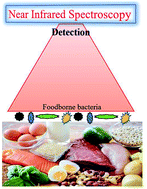Advances in differentiation and identification of foodborne bacteria using near infrared spectroscopy
Abstract
Rapid and sensitive detection of foodborne bacteria is a growing concern for ensuring safe food supply and preventing human foodborne infections. It is difficult for conventional methods to meet these detection requirements because they are often tedious and time-consuming. In the recent years, near infrared (NIR) spectroscopy has been found to be a promising method for all sorts of analyses in microbiology due to its highly specific absorption signature and non-destructive measurements. In this review, we first briefly introduce the fundamental and basic operational procedure of NIR spectroscopy for foodborne bacteria detection. Then we summarize the main advances and contributions of this technique in the study of foodborne bacteria. Finally, we conclude that much work still remains to be done before NIR spectroscopy really becomes a viable alternative in the field of microbiological characterization.

- This article is part of the themed collection: Analytical Methods Review Articles 2021


 Please wait while we load your content...
Please wait while we load your content...